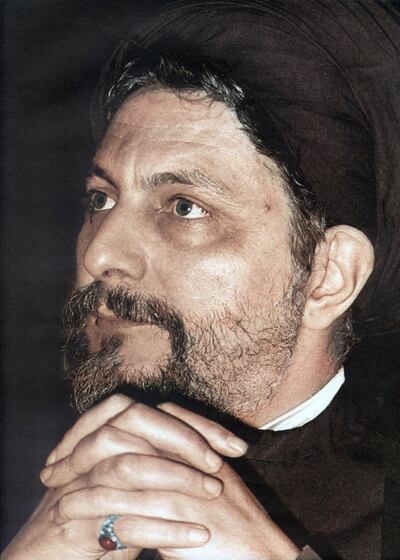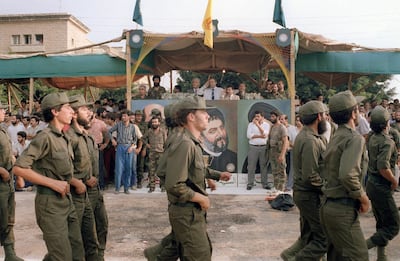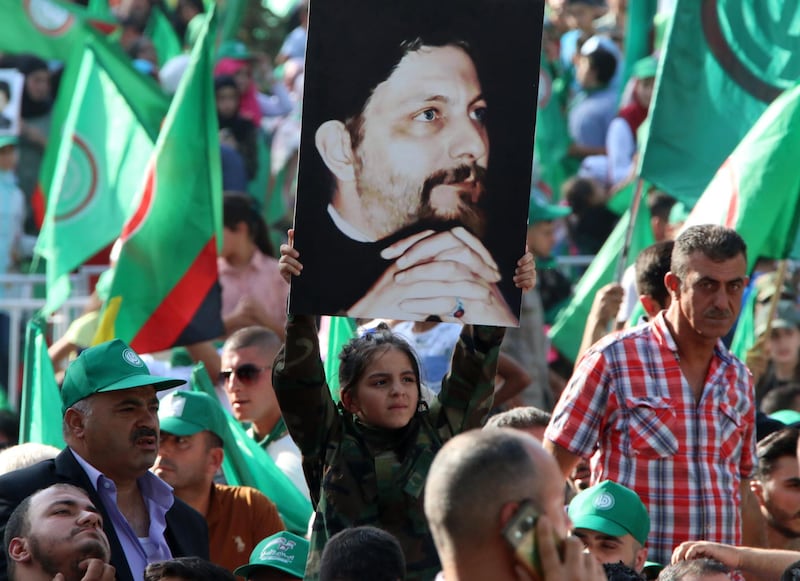Imam Musa Sadr, the most prominent and charismatic Shia voice in the decade prior to the outbreak of the Lebanese civil war in 1975, disappeared alongside sheikh Muhammad Yaacoub and journalist Abbas Badreddine during an official visit to Libya in August 1978.
Although he’s been missing for 40 years, the political consequences are still resonating in Lebanese politics today. Despite the intervening decades, the fate of Muammar’s Gaddafi’s son is now tied to the case.
Lebanon accuses Libya’s former authoritarian leader of being responsible for his disappearance. It led the small eastern Mediterranean country to cut diplomatic relations until the Gaddafi regime was toppled in 2011.
Founded by Mr Sadr in 1974, his Amal party maintains his memory by placarding pictures of the green-eyed Imam in its strongholds and organizing mass rallies every year to mark the disappearance.
Thousands of people gathered in a park in the centre of the Lebanese Bekaa Valley town of Baalbek last Friday for the 40th anniversary of his fated visit, as military-style music blared out of giant loudspeakers above the crowds.
"Gaddafi and other Arab states conspired to kidnap him so that we would continue fighting each other", 26-year-old Moussa Hamoud told The National, rehashing a well-worn explanation for his disappearance.
For Mr Hamoud, as for many Lebanese, Musa Sadr was a brave leader whose calls for peace and interreligious dialogue were silenced too soon. To prove his point, the young man unwrapped the flag he was carrying to show a black and white picture of Mr Sadr and a Christian leader, Gregoire Haddad, smiling to each other.
When the Gaddafi regime fell in 2011, the Lebanese government hoped the mystery would finally be solved.

A special committee was set up by the government. Headed by judge Hassan Chami, it met dozens of key figures of the outgoing Gaddafi regime, including intelligence chief Abdullah Senussi and former Foreign Minister Moussa Koussa.
“They didn’t tell us the truth”, Mr Chami says. “They accuse everybody but Gaddafi, from the Iranian secret police to Mossad and Abu Nidal [the leader of Palestinian splinter faction, Fatah - Revolutionary Council]”.
______________
Read more:
The future of Lebanon's political dynasties
UN urges Lebanon to act over freedom of expression crackdown
UN Security Council unanimously renews UNIFIL mandate in Lebanon
______________
But Mr Chami believes the truth is clear - Gaddafi saw Mr Sadr’s growing influence in south Lebanon as an obstacle to his attempts to control the region. He kidnapped him and held him in at least three different prisons across the country.
But not everyone believes in Gaddafi’s guilt.
Lebanese veteran journalist and founder of the now-shuttered As-Safir, Talal Salman, remembers a conversation with Gaddafi in March 1979. “He asked everybody around us to leave before asking me in an angry voice, ‘Who is Musa Sader? I’ve never met him. He’s just another sheikh’. He didn’t even understand his importance”, Mr Salman remembered.
He says he personally met Mr Sadr in Al Shati Hotel in Tripoli, in Libya, a few days before he disappeared. Along with thousands of others, they had been invited by the Libyan government for the yearly September 1 celebration of the Libyan coup d’état which brought Gaddafi to power.
With several colleagues, Mr Salman spent a few hours talking to Mr Sadr in his hotel room on the night of August 28, 1978. “He absolutely wanted to meet Muammar Gaddafi to ask him to talk to Abou Ammar [Yasser Arafat] about the situation in south Lebanon. He said several times that he needed to leave Libya before September 1. The next day, we didn’t see him at the hotel, and assumed he’d left”.
For nearly four decades, speculations and conspiracy theories abounded, but Mr Sadr’s body was never found. As the case remains unsolved, he has become a somewhat mystical figure neither dead nor alive.
“You will come back one day”, reads a banner on the side of the road to Baalbek, echoing the Shia belief of “occultation” - that the hidden Imam will return at the end of times. If he returned today, Mr Sadr would be 90 years old.
Sociology professor, an expert in Islamist political movements, Waddah Charara said that Mr Sadr had many enemies. “Many Arab leaders wanted Musa Sadr to disappear”, he explained.
Gaddafi’s motive, he says, was that he favoured Palestinian armed struggle while Mr Sadr wanted to limit PLO military action against Israel from Lebanon. Iranian Supreme Leader Ruhollah Khomeini considered him to be too moderate and former Syrian President Hafez Al Assad wanted to control the Shia resistance against Israel and didn’t want to deal with an uncontrollable leader like Mr Sadr, he argues.

Then, in December 2015, another breakthrough appeared as a new generation took up the mantle of revenge.
Hassan Yaacoub, the son of Mr Sadr’s companion, Muhammad Yaacoub, kidnapped Muammar Gaddafi’s son, Hannibal, in Damascus and brought across the border to Lebanon.
Badly beaten, the younger Gaddafi, in his early-40s, appeared in a video broadcast by local television asking anyone with information about Mr Sadr to come forward.
Hannibal was then handed over to Lebanese authorities who questioned him as a witness in Mr Sadr’s disappearance before arresting him for withholding information, says Mr Chami. His abductor was sent to prison for a few months for his kidnap.
According to Mr Chami, Mr Sadr was alive “at least 15 to 20 years” after he disappeared. That explains why the Lebanese authorities believe Hannibal Gaddafi could hold crucial information to the fate of the sheikh, even though he was barely three years old in 1978.
Read more:
Libya court sentences 45 to death over 2011 killings
For nearly three years now, Hannibal has been held in a detention facility in central Beirut, in the upscale neighbourhood of Ashrafieh. The press is barred from meeting him, and his visitors from abroad are denied visas, says Ms Khalil. “He will stay there for an unlimited amount of time - until [the investigative judge] Zaher Hamadeh has finished his work”, says Mr Chami.
Several other cases were brought against Hannibal, including links to a strange kidnapping by a Lebanese national in Libya and was sentenced in a side case for demeaning judicial authority by disrespecting a judge when, during a hearing, he appeared to question the logic of the charges being brought against him. But nothing new has emerged since regarding Mr Sadr’s disappearance.
Ms Khalil, his ex-lawyer, argues that Hannibal Gaddafi knows nothing. “He told me that he heard Musa Sadr’s name mentioned only once at the end of a meeting held by his brother, [former National Security Adviser Mutassim]. Abdessalam Jalloud was said to be responsible for his disappearance, that’s all he knows” he said of the former Libyan Prime Minister who subsequently fell out with Gaddafi.
Mr Charara says he thinks current Amal leader and speaker of parliament Nabih Berri keeps Hannibal in custody as a form of “revenge” for Musa Sadr’s disappearance while keeping an eye on his financial assets. The Gadaffi family are believed to have plundered hundreds of millions from the oil-rich Libyan treasury and hidden much in personal accounts around the world. Should the family mobilize what is left of its fortune, his freedom could be negotiated. “They still have a few dozen million dollars in Lebanese banks”, says Mr Charara.
Negotiations will remain at a standstill until Hannibal’s older and more prominent brother, Saif Al Islam, publicly re-surfaces after over a year in hiding, Mr Charara says.
Mr Al Islam, Gadaffi’s second son, was a close advisor to his father. He carried out diplomatic and public relations duties for the regime.
His reappearance may be very soon. In March he reportedly announced his intention to run for the Libyan presidency at the end of the year, but he’s not been seen publicly since just after he was freed in 2017 by a militia group that had held him for six years. Mr Al Islam’s location remains unknown.
For Mr Charara, “it’s only then that real negotiations will start and that Hannibal’s fate will be decided. Saif Al Islam is the one with key information”.






